Do you ever experience difficulty bending forward due to lower back pain? Have you noticed that your lower back feels stiff and hurts when you get up after sitting for a while?
Do you want to strengthen your lower back at home? Then, you should read this blog and start incorporating it into your home workout routine.
This guide provides a series of simple yet effective exercises for the lower back, including strengthening and stretching exercises.
These exercises will not only improve your lower back’s feel but also protect it from future injuries.
The best part? You can do them easily at home and adjust them to your busy schedule.

- 12 Best Lower Back Home Exercises
- 1. Knee-to-chest stretch
- 2. Hip Bridge
- 3. Plank
- 4. Bird Dog
- 5. Lying Bent-Knee Twist
- 6. Superman
- 7. Side Plank
- 8. Lying Straight Leg Raise
- 9. Cat-Cow
- 10. Abdominal Drawing-In Maneuver
- 11. Floor Back Hyperextension
- 12. Good Morning
- Tips and Techniques For Lower Back Workout
- Warnings
- FAQs
- Can I strengthen my lower back at home without any equipment?
- Can yoga help strengthen my lower back?
- Takeaway
- References
12 Best Lower Back Home Exercises
We know that having a strong and healthy back is important because it helps your body and maintains good posture. That’s why we made a list of exercises for your lower back that will help you get stronger, more flexible, and more stable.
This workout routine includes the best exercises for strengthening and building muscle in your upper and lower back, both for your superficial muscles (those closer to the skin) and deep muscles (those closer to bone and internal organs).
These back exercises also strengthen the glutes, hamstring, quadriceps, obliques, Rectus abdominis.
Now, let’s talk about the best exercises for strengthening your lower back and improving your posture. You can use bodyweight and basic fitness equipment to do those exercises at home.
1. Knee-to-chest stretch
The knee-to-chest is a low-impact stretch that targets the quadratus lumborum, hip flexors, and posterior chain.
This technique gently stretches the muscles and ligaments surrounding your spine, thereby reducing tightness and alleviating pain caused by muscle spasms or stiffness.
It can be performed at home or anywhere with a suitable, comfortable surface.
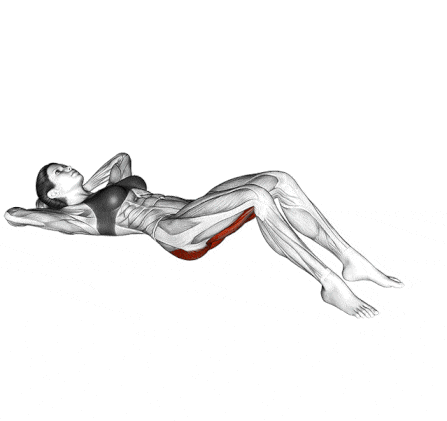
How To Do It
- Lay on your back with your knees bent and feet flat on the floor.
- Pull up one knee and press it toward your chest.
- Tighten the muscles in your belly and press your spine to the floor. Hold for five seconds.
- Return to the starting position and repeat with the other leg. Go back to the starting position.
- Then, repeat with both legs at the same time. Repeat each stretch 2 to 3 times.
- If possible, do the full routine once in the morning and once in the evening.
2. Hip Bridge
The hip bridge is a good starter move for the butt, hamstring, and lower back muscles. It is the best exercise to manage chronic lower back pain.
When you sit for most of the day, your glute muscles can weaken and the hip flexors in the front of your thighs can become shorter, making them feel tight.
But when you practice glute bridges regularly, you target your glutes and lower back muscles, and those muscles meant to hold your body upright will strengthen.
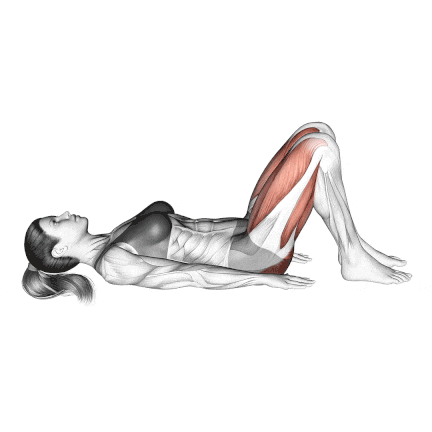
How To Do It
- Lie down on the floor with your knees bent and your feet flat on the ground.
- Keep your arms at your side with your palms down.
- Lift your hips off the ground until your knees, hips, and shoulders form a straight line.
- Don’t overextend your back during the exercises, this may cause lower back pain.
- Squeeze your glutes hard and keep your abs drawn in to avoid overextending your back during the exercise.
- Hold your bridged position for a couple of seconds before easing back down.
- To make it more challenging, hold a weight plate on your lap.
3. Plank
The Plank is a popular core-strengthening exercise that targets multiple muscles, including the abdominals, back, and stabilizing muscles.
It is an isometric exercise where you hold a position similar to the top of a push-up, with the body’s weight borne on forearms, elbows, and toes.
Although the plank focuses on the core, it also engages other muscle groups, including the shoulders, glutes, and legs. It contributes to better posture, reduces the risk of back pain, and promotes proper alignment.
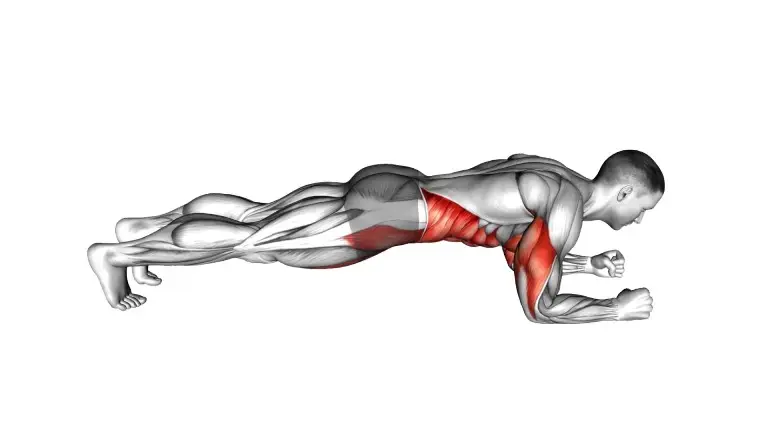
How To Do It
- Place your forearms on the ground and your elbows below your shoulders.
- Engage your core by drawing your navel toward your spine and squeezing your glutes.
- Your body should form a straight line from your shoulders to your ankles.
- Do not let your lower back sag or your butt rise. Ensure your body is straight and rigid.
- Keep your neck relaxed and look down at the floor to avoid straining your neck.
- Hold the position for 20-30 seconds, gradually increasing time as you build strength and endurance.
- Lower your knees to the ground and rest to get out of the Plank.
Know More: Plank Exercise: Benefits, Variations, Muscles Worked, Tips
4. Bird Dog
The bird dog is an elegant exercise that is very effective for training the abdominal and lower back muscles. Several other muscles are also addressed, including the glutes.
The bird dog is a real stability exercise that ensures a stable trunk. It owes its name to the position alternating between sitting on hands and knees (dog) and stretching the arms and legs (bird).
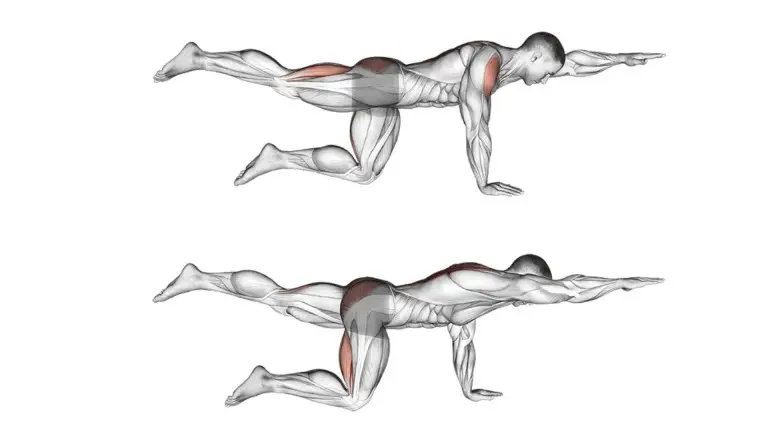
How To Do It
- Get on your knees and place your hands on the floor in front of your body at shoulder width.
- Contract your abs and lift one hand and the opposite knee slightly off the floor.
- You are now balancing on the other hand and knee.
- Now extend your arm and leg out. Try to form a straight plane from your hand to your foot.
- Hold this position for about 10 seconds and then return to the starting position.
- This exercise gets harder when you perform the exercise on your toes instead of your knees.
Know More: 21 Bodyweight Shoulder Exercises: Beginner to Advance
5. Lying Bent-Knee Twist
The Lying Bent-Knee Twist, also known as the Supine Spinal Twist or Supine Twist, is a gentle stretching exercise that involves rotating the spine while lying on your back with bent knees.
It helps improve spinal mobility and flexibility by gently rotating the vertebrae, relieving tension and stiffness in the lower back.

How To Do It
- Lie on your back on the floor or mat with arms extended out to the sides to keep your body stable during the exercise.
- Raise and bent legs at a 90-degree angle, so thighs are vertical and lower legs are horizontal.
- Keeping your shoulders in contact with the floor, slowly lower your legs to one side until you feel a mild stretch in your lower back.
- Hold the stretch for 20-30 seconds while focusing on deep, relaxed breathing.
- Now, rotate your legs all the way to the right.
6. Superman
Superman is an effective exercise for strengthening the lower back, core, and glute muscles. If done regularly, it may help alleviate back pain related to weak back muscles.
The primary focus of the Superman exercise is to target and strengthen the erector spinae muscles in the lower back.
In addition to strengthening lower back muscles, it also works on your glutes and hamstring muscles.
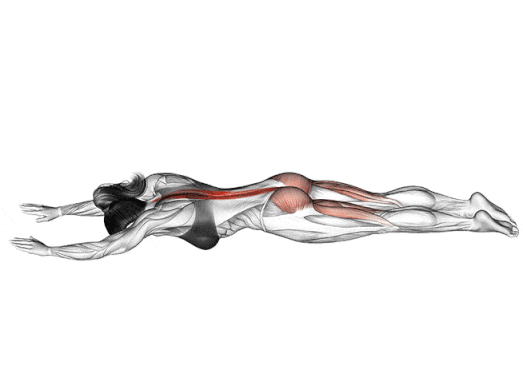
How To Do It
- Lay with your stomach flat on the ground.
- Extend your arms in front of you, with your palms facing down.
- Lift your head and raise your arms and your chest off the ground as far as possible.
- Lift your thighs off the ground, as much as possible. (Try to make a big “U” with your back.)
- Hold the lifted position for a few seconds while engaging the target muscles.
- For your first few workouts, try holding for only 5 or 10 seconds, and then gradually increase to 30 seconds.
- Slowly lower your arms and legs back to the starting position.
- Start with a comfortable range of motion.
7. Side Plank
Side Plank is a core-strengthening exercise that primarily targets the oblique muscles, but also engages the entire core and stabilizing muscles.
The exercise activates the core, including the deep abdominal muscles (transverse abdominis) and the lower back muscles.
If you find the exercise challenging, modify it by bending your knees and resting on your bottom knee instead of your feet.
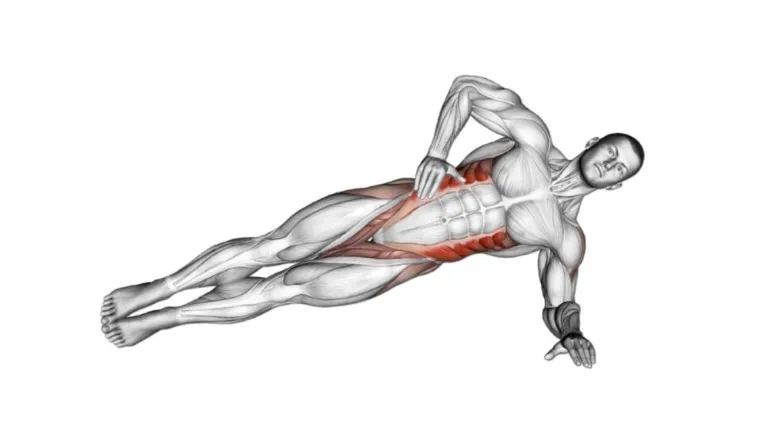
How To Do It
- Lie on your left side on the floor, with your right foot on top of your left foot and your right arm resting on your side.
- Raise your body by placing your left forearm flat on the floor so that it’s perpendicular to your torso.
- Lift your torso until your left upper arm is straight underneath you, with your elbow bent 90 degrees and your forearm flat on the floor.
- In this position, only your left forearm touches the floor, and your body forms a diagonal line at a 20-degree angle to it.
- Keep your abs pulled in tight and hold this position for as long as you can, and then repeat on the left side.
8. Lying Straight Leg Raise
Lying leg raises are touted as the best core exercise. But your hip flexors actually reap some major benefits of this move. So don’t be surprised if your hips feel a bit of a burn during this one.
It can also help alleviate low back pain since it improves your core’s strength and stabilization.
It is often used in Physical Therapy to help patients improve the strength of their lower extremities.
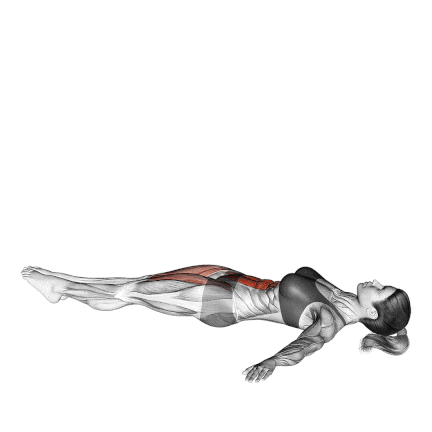
How To Do It
- Lie face up on the floor/bench with your entire body straight and your hands at your sides to stabilize your torso.
- Hold your legs a few inches off the floor.
- Raise your legs up toward the ceiling until they are just short of perpendicular to the floor.
- Slowly lower your legs back to the starting position.
9. Cat-Cow
This is a good place to start if you struggle with back mobility.
The cat-cow exercise is a spinal mobilization exercise that helps you “loosen” your spine. It improves movement of your lower back. It is a great way to mobilize your spine and the muscles responsible for extending it.
To do the cat-cow, the person is on their hands and knees and bends the spine up (like a cat) and then curves it downward (so your stomach hangs to the floor, like a cow).
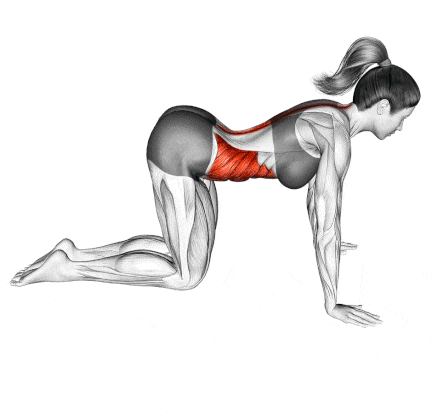
How To Do It
- Begin with your knees beneath your hips and your spine in a neutral position.
- Sink your back down towards the floor and lift your head up simultaneously, sticking your tailbone out to curve your spine.
- Return to the initial position, and then tuck your head and tailbone in, arching through your spine as to mimic a camel hump. Take a big breath in at the same time.
- Move back and forth slowly, without pushing at either end of the movement.
- Aim to do these movements for 8-10 repetitions and fully mobilize your lumbar spine or lower back area.
10. Abdominal Drawing-In Maneuver
The abdominal drawing-in maneuver is an isometric exercise that involves gently contracting your deep core muscles, specifically the transverse abdominis (TA).
Think of it as pulling your belly button towards your spine while maintaining normal breathing. This subtle movement activates the TA, a key muscle for stabilizing your spine and pelvis.
Unlike traditional crunches or sit-ups, the ADIM is a low-impact exercise that puts minimal stress on your spine.
How To Do It
- Lie on your back with your knees bent and feet flat on the floor. You can also perform the ADIM while sitting or standing.
- Gently draw your belly button in towards your spine, as if you’re trying to zip up a tight pair of pants.
- Imagine pulling your navel towards your back without tilting your pelvis or holding your breath.
- Maintain the contraction for 5–10 seconds while breathing normally. Avoid sucking in your stomach excessively or using your hip flexors.
- Relax your abdominal muscles and repeat for 10–15 repetitions.
11. Floor Back Hyperextension
According to the study, back hyperextension is an effective low-impact exercise targeting lower back muscles. It is beneficial for athletes and individuals who need to strengthen their posterior chain (gluteus maximus, hamstrings, and lower back muscles)
To avoid injury, it is important to use proper form and begin with lighter weights or bodyweight before progressing to heavier weights.
You can also use different tools to do back extensions, like a hyperextension bench, a Roman chair, or just standing on the floor.
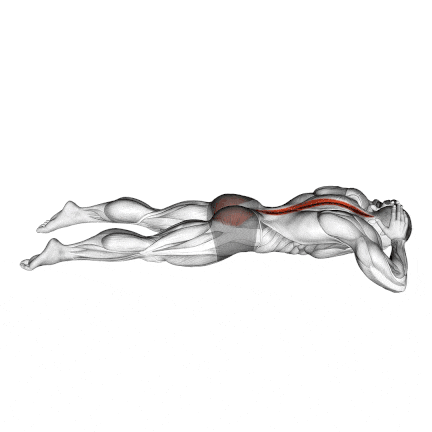
How To Do It
- Lie face down on the floor or a mat with your arms extended overhead and your legs straight.
- Tighten your abdominal muscles to stabilize your spine and protect your lower back.
- Place your hands on your chest (or behind your neck).
- Slowly raise your head, chest, and arms off the floor, keeping your neck neutral.
- To avoid straining your neck, your gaze should be slightly downward, not straight ahead.
- Hold the position for a few seconds and squeeze your shoulder blades together.
- Gently lower your upper body back to the starting position. Repeat for 10–15 repetitions.
12. Good Morning
Good morning is a compound exercise that primarily targets the posterior chain muscles, including the hamstrings, glutes, and lower back.
When done with solid spinal alignment and perfect form, it is one of the best exercises for improving back health and alleviating lower back pain.
To allow your lower back to get used to the good morning exercise, start with bodyweight or a stick and add more weight slowly.
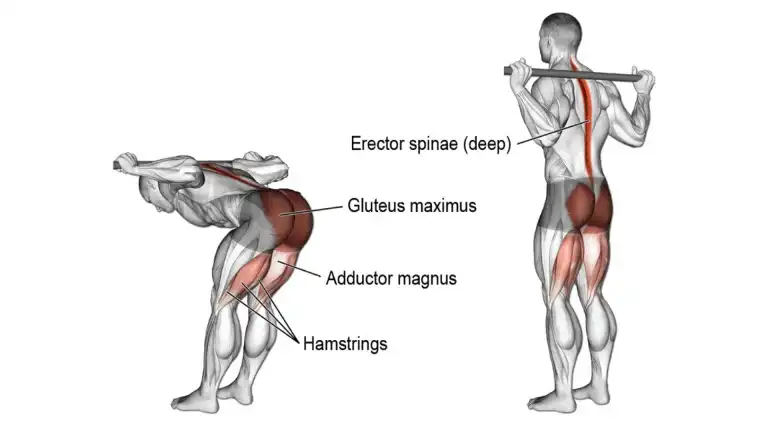
How To Do It
- Stand with a stick on your back and grab it from either side.
- Keep your knees bent and your back and neck in a neutral position.
- Slowly hinge forward at the hips while maintaining a slight knee bend.
- Lower your torso until you feel a stretch in your hamstrings.
- Keep your weight on your heels and avoid rounding your back or letting your knees collapse inward.
- Pause at the bottom, then return to the starting position by driving through your hips and engaging your hamstrings and glutes.
Tips and Techniques For Lower Back Workout
Strengthening the lower back should make you healthier and fitter while reducing pain. On the other hand, working out incorrectly can cause injury or worsen the pain. Before getting into a low-back strength routine, keep safety in mind.
Here is an exercise routine that strengthens your back.
- Always warm up your lower back before you exercise to increase blood flow and loosen up the muscles.
- You can choose any 3-4 exercises and do 3–4 sets of 10–15 reps of each.
- You can either use a set of light weights or do each back exercise as a bodyweight exercise.
- Remember, the goal of this exercise is to complete it with proper form, while still challenging your body.
- Perform lower back exercises with slow and controlled movements.
- If you have any limitations or injuries, modify exercises to suit your needs.
- It is recommended to incorporate exercises that emphasize both the flexibility and strength of the lower back.
- If you have questions about a specific exercise or what would be best for you, consult a personal trainer or coach first.
- If you already have an exercise routine, you could try adding these exercises to help strengthen your lower back.
- After completing your back workout, spend a few minutes on a cool-down routine. Stretching the lower back and surrounding muscles can help prevent post-workout stiffness.
- Give your lower back muscles ample rest and recovery time between workouts.
Warnings
Always consult a doctor before beginning a new exercise program. For those experiencing persistent or strong back pain, visit your healthcare provider or physical therapist before beginning a workout routine (even with a personal trainer).
If you experience a traumatic injury such as a fall or accident, always seek medical help and further evaluation to rule out serious conditions.
If these exercises cause your back pain to increase, stop and seek medical help. Only work within your physical limits. Doing too much or too fast can increase back pain and slow the healing process.
The information contained in this article is for educational and informational purposes only and is not intended as health advice.
FAQs
Can I strengthen my lower back at home without any equipment?
Yes, several lower back exercises can be done without equipment. Bodyweight exercises like bridges, supermen, and bird dogs strengthen the lower back.
Can yoga help strengthen my lower back?
Yes, yoga can be beneficial for strengthening the lower back and improving flexibility. Poses like cat-cow, child’s pose, and sphinx pose target the lower back muscles. Consider incorporating yoga into your routine to enhance lower back strength.
Takeaway
These exercises are highly recommended for anyone interested in strengthening back muscles and improving posture. Perfect posture gives you command, confidence, and less stress on your back.
Low-back strengthening exercises are an excellent way to prevent recurring back pain.
Increased stability, decreased chances of getting injured and improved function can be achieved by stronger core muscles.
Start incorporating these simple exercises into your daily routine and you will reap the benefits for a long time.
References
- James Rainville, Carol Hartigan, Eugenio Martinez, Janet Limke, Cristin Jouve, Mark Finno: Exercise as a treatment for chronic low back pain. PMID: 14749199 DOI: 10.1016/s1529-9430(03)00174-8
- A Murtezani, H Hundozi, N Orovcanec, S Sllamniku, T Osmani: A comparison of high intensity aerobic exercise and passive modalities for the treatment of workers with chronic low back pain: a randomized, controlled trial: PMID: 21602759
- Rahman Shiri, David Coggon: Exercise for the Prevention of Low Back Pain: Systematic Review and Meta-Analysis of Controlled Trials: American Journal of Epidemiology, Volume 187, Issue 5, May 2018, Pages 1093–1101
- Suh, Jee Hyun MD; Kim, Hayoung BS; Jung, Gwang Pyo MD; Ko, Jin Young MD; Ryu, Ju Seok MD, PhD: The effect of lumbar stabilization and walking exercises on chronic low back pain: June 2019 – Volume 98 – Issue 26 – p e16173 doi: 10.1097/MD.0000000000016173
- Manniche C, Lundberg E, Christensen I, et al. Intensive dynamic back exercises for chronic low back pain: a clinical trial. Pain 1991;47:53–63.
- Hartigan C. Exercise-based therapy for low back pain. https://www.uptodate.com/contents/search. Accessed April 19, 2023.
- Spine conditioning program. American Academy of Orthopaedic Surgeons. https://orthoinfo.aaos.org/en/recovery/spine-conditioning-program/. Accessed April 19, 2023.
- Bydon M. Physical therapy. In: Back and Neck Health. Mayo Clinic Press; 2021.
- Dutton M. Lumbar spine. In: Dutton’s Orthopaedic Examination, Evaluation, and Intervention. 6th ed. McGraw Hill; 2022. https://accessphysiotherapy.mhmedical.com. Accessed April 24, 2023.

Manish is a NASM-certified fitness and nutrition coach with over 10 years of experience in weight lifting and fat loss fitness coaching. He specializes in gym-based training and has a lot of knowledge about exercise, lifting technique, biomechanics, and more.
Through “Fit Life Regime,” he generously shares the insights he’s gained over a decade in the field. His goal is to equip others with the knowledge to start their own fitness journey.
